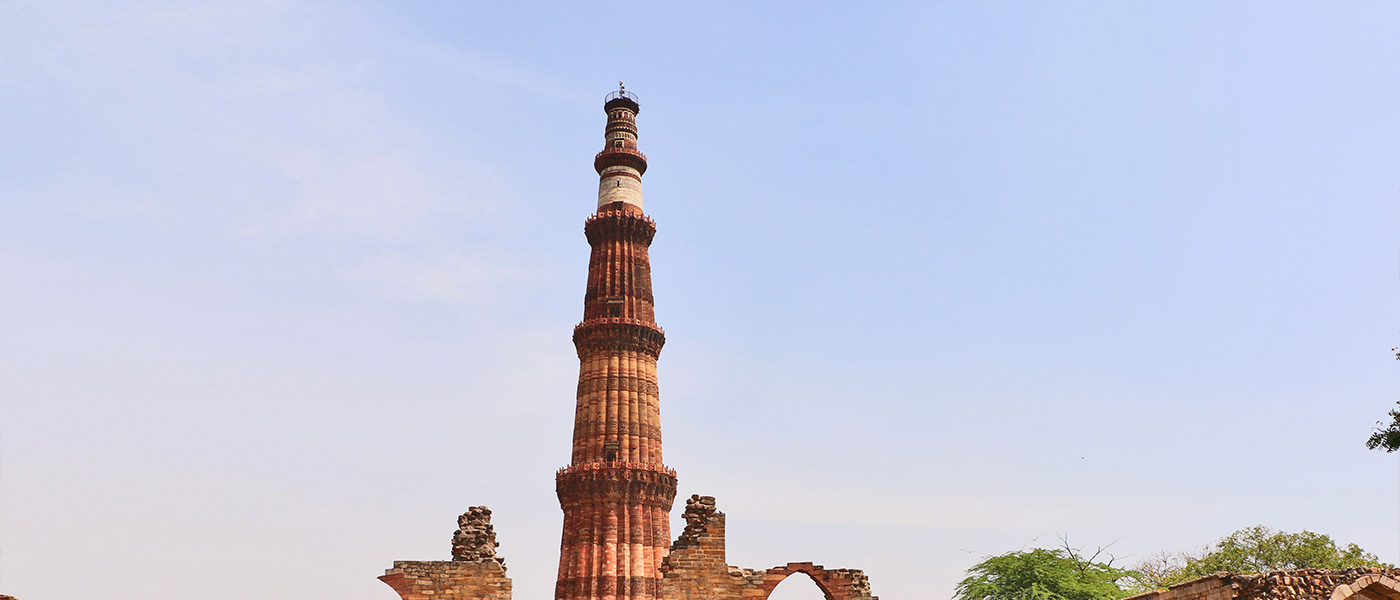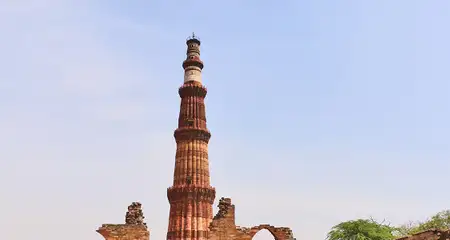A Towering Monument Reflecting History and Heritage
The Qutub Minar also spelled Qutb Minar and Qutab Minar in Delhi is a towering landmark which never fails to fascinate visitors. And why not! After all, it’s not every day that you come across an architectural masterpiece that boasts of being the world’s tallest brick tower and has remained so for more than 800 years. Isn’t that enough a reason to include this prime tourist attraction in your itinerary when you plan your trip and book your hotels in Delhi?
But is that all there is to this centuries-old historic monument in Delhi? Of course not! From its illustrious history to grand architecture, everything about this structure is awe-inspiring. This blog covers the history, architecture, timings, entry fee, and other details about Qutub Minar.
Qutub Minar Information: Quick Facts, Timings, Ticket Price
| Qutub Minar Location | Mehrauli, Delhi |
| Status | UNESCO World Heritage Site |
| Timings | 7:00 am to 5:00 pm; every day |
| Entry Fee | ₹30 for Indians; ₹500 for foreigners; free for children below 15 years |
| Still Camera | ₹25 (non-commercial use) |
| Video Camera | ₹25 (non-commercial use) |
| Nearest Metro Station | Qutab Minar |
Qutub Minar History
Delhi’s Qutub Minar is a five-storied structure constructed over four centuries by a number of rulers. It was originally commissioned by Qutb-ud-din Aibak, who was the founder of the Delhi Sultanate, around 1192 as a victory tower. The minaret is named after him; although he wasn’t able to build it beyond the first story. His successor Shams-ud-din Iltutmish added three more floors to the structure in 1220. Its topmost story suffered damages in 1369 due to lightning. It was reconstructed by Firoz Shah Tughlaq, who added the fifth and final story to the tower while the entrance to Qutub Minar was built by Sher Shah Suri.
Around 300 years later, in 1803, the tower again suffered severe damages in an earthquake. Major Robert Smith, a member of the British Indian Army, mended the structure in 1828. He went ahead and installed a pillared cupola to sit atop the fifth story, thus lending the tower its sixth story. But this extra story was removed in 1848 under the orders of Henry Hardinge, the then Governor-General of India, and reinstalled next to the minaret. Entry to the tower has been restricted since 1981 after an accident, which left 47 people inside it dead.
Book Hotels – Budget Hotels in Delhi | Couples Friendly Hotels in Delhi
Qutub Minar Height & Architecture
The magnificent Qutub Minar has a height of 73 meters. It has a base diameter of 14.3 meters which narrows down to 2.7 meters at the top. The structure also includes a spiral staircase of 379 steps. There are many other historical edifices around the minaret which, together with the main tower, form the Qutub Minar Complex.
It is widely believed that the tower, which displays early Afghan architectural style, was built taking inspiration from the Minaret of Jam in Afghanistan. Each of the five distinct stories of the minaret is adorned with a projecting balcony supported by intricately designed brackets. While the first three stories are built in pale red sandstone, the fourth one is purely made of marble, and the fifth one is a mix of marble and sandstone. The architectural styles from the base to the top also differ, thanks to the many rulers who constructed it part by part.
There are bands of inscriptions on different sections of Qutub Minar that narrate its history. Carved verses adorn the inside of the tower.
About Qutub Minar: Today
Today, this monument is a popular tourist attraction in Delhi and a part of the Qutub Minar Complex. It is also one of the UNESCO World Heritage Sites in Delhi, a status granted to it in 1993 for its historical importance and architectural brilliance.
Qutub Festival, an annual cultural event, is held at this complex every year during the month of November-December. This three-day long festival witnesses a lively gathering and various mind-blowing performances by musicians, dancers, and artists.
The Qutub Minar complex is under the protection of the Archeological Survey of India under its Delhi circle of monuments.
Things to See in the Qutub Minar Complex
The Qutub Minar Complex in Delhi has myriad attractions for all the history buffs out there. The main structures in the complex include:
- Quwwat-ul-Islam Mosque, a magnificent monument
- Ala’i Darwaza, a domed gateway to the mosque from the south side
- Iron Pillar of Chandragupta II, which never rusts
- Tomb of Iltutmish, who was the second ruler of the Delhi Sultanate
- Tomb of Imam Zamin, who was a Turkestani cleric
- Alauddin Khilji’s tomb and madrasa
- Alai Minar, the unfinished victory tower of Khilji
- Smith’s Folly, the cupola that was once installed on top of the tower
- Sanderson’s Sundial, a sundial designed in white marble
Lesser-Known Information about Qutub Minar
- The word Qutub Minar means pole or axis in Arabic.
- In 2006, the Qutub Minar Complex attracted 3.9 million visitors, making it the most visited monument of India for that year.
- The design of Mini Qutub Minar in West Delhi’s Hastsal village and Chand Minar in Daulatabad were inspired from this tower.
- The striking minaret is featured on the tokens and travel cards issued by the Delhi Metro Railway Corporation.
- In 2019, the Archeological Survey of India started illumination work of the complex to promote night tourism in Delhi. Read FabHotel’s report on the same here.
Places to Visit near Qutub Minar
- Tomb of Adham Khan (850 m)
- Dargah of Hazrat Khwaja Qutbuddin Bakhtiar Kaki (1.4 km)
- Zafar Mahal (1.5 km)
- Jahaz Mahal (2 km)
- Hauz-i-Shamsi (2.1 km)
- Jamali Kamali Mosque and Tomb (3.3 km)
- Tomb of Balban (3.3 km)
Now you know why this heritage monument is regarded as one of the best tourist places in Delhi along with the famous Mehrauli Archaeological Park nearby. So, go ahead and spend a day exploring this architectural marvel that has been standing guard over Delhi for ages.
Frequently Asked Questions About Qutub Minar:
Q: When was Qutub Minar built?
A: The construction of Qutub Minar was started by Qutub-ud-Din Aibak in 1193; however, it was given the final shape by Firoz Shah Tughlaq in the year 1368.
Q: Who built Qutub Minar?
A: The Minar was built by Qutbu’d-Din Aibak in 1199 AD.
Q: What’s the height of Qutub Minar?
A: Qutub Minar has a soaring height of over 73 metres or 240 feet.
Q: Where is Qutub Minar located?
A: Qutub Minar is located in the Mehrauli area of New Delhi.
Q: What is inside Qutub Minar?
A: The Qutub tower has 397 steps across 5 distinct storeys (each featuring a balcony supported by intricate brackets). Besides, the Qutub complex has a mosque – Quwwat Ul Islam (Light of Islam), a rust-proof Iron Pillar, and Ala’i Darwaza, a domed gateway to the mosque.
Q: Is Qutub Minar open at night?
A: In an initiative to increase night tourism, the opening timing of Qutub Minar has been extended to 10 PM on all days.
Q: What is Alai Darwaza and who constructed it?
A: Alai Darwaza is an entrance gateway to Quwwat Ul Islam mosque inside the Qutub complex. It was built by the 14th century ruler Alauddin Khalji.
Q: Can I get Qutub Minar ticket online?
A: Yes, Qutub Minar entry ticket is available online.
Q: What are Qutub Minar timings?
A: Day Time: 7 am – 5 pm | Evening Time: 7 pm – 10 pm




























